Rich in vitamins and minerals, crispy, crunchy romaine lettuce has 8 calories per cup. Learn how to store, wash, and cut it for any healthy romaine recipe.
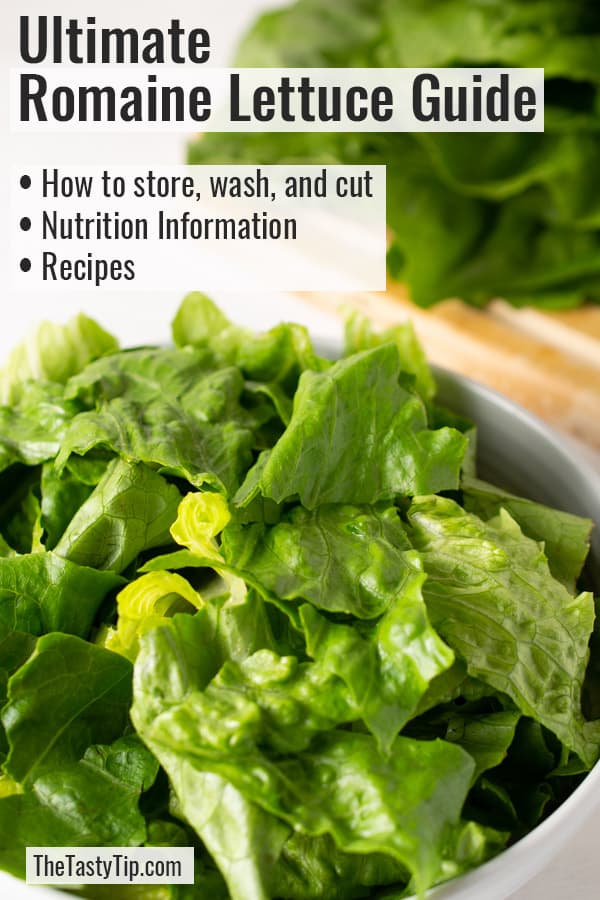
Romaine Lettuce, also known as “cos” lettuce in England, has been eaten for almost 5,000 years. It originated off the Greek Island of Cos and is considered to be the oldest form of cultivated lettuce.
Romaine grows in a tall head with long, narrow, thick leaves growing tightly together. The ribs are firm and crunchy and the crisp leaves can be dark green to pale green. The inner leaves are a lighter green than the outer leaves.
It has a mild, sometimes slightly bitter flavor. It tastes good with other leafy greens, both mild and bitter. I routinely mix romaine and kale in salads.
When is Lettuce Season?
Romaine lettuce grows best in the cool seasons of the year, although it is available in the store year round. California and Arizona produce the most lettuce in the United States.
Beware of Pesticide Contamination
Buy and eat organic lettuce whenever possible.
Why? The 2019 Dirty Dozen Shopper’s Guide lists lettuce as #15 for the amount of pesticides used to grow it.
The "What’s on my food" website summarized the pesticides found on lettuce during the 2011 USDA Pesticide Data program. During this study spanning several years, the USDA sampled lettuces from all over the United States.
They found a whopping 52 pesticides on the combined samples of conventionally grown lettuce. Some of the pesticides found are known or suspected to be carcinogens, hormone disruptors, neurotoxins and developmental or reproductive toxins.
Bottom line -- choose to eat organic romaine lettuce when possible.
How to Select the Best Romaine Lettuce
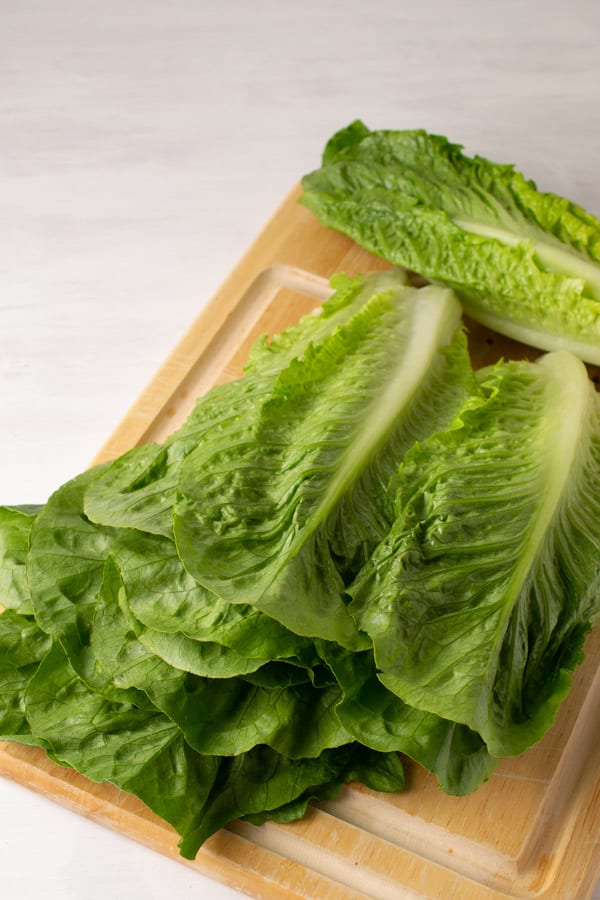
Crisp is the key to choosing the best lettuce. Look for leaves that look crisp and fresh. Avoid lettuce that has tough leaves, is wilting, has brown or moldy spots, or that is cracking at the ribs.
The best place to find lettuce (outside of your own garden) is at a farmers market. This lettuce was likely picked the day before, so it will be very fresh.
How to Store Romaine Lettuce
Do not wash or cut lettuce until you are ready to use it. Wrap the lettuce leaves loosely in a paper towel to absorb moisture.
Place the wrapped leaves in a food-grade plastic bag (produce bag) or zip top bag and keep it partially opened to allow a small amount of air circulation. Store the leaves in the refrigerator.
If you are looking for more earth-friendly options, try cloth food storage bags. Keep in mind that moisture can evaporate quicker with these bags, so the lettuce may not stay fresh for as long.
Another option is a produce box that allows just a little air to circulate. One benefit of the produce box is that the hard sides protect the lettuce from getting bruised or damaged.
Note: Bananas, apples, pears, and tomatoes give off ethylene that causes lettuce to brown pre-maturely. So don’t store your romaine next to these foods.
How to Store Leftover Lettuce
The best way to store leftover lettuce that has been washed is in a produce box lined with a paper towel to absorb moisture.
How Long Does Romaine Lettuce Stay Fresh?
For best results, eat the lettuce within a couple of days of purchasing. However, because romaine lettuce has tighter leaves, it can still be fresh after being refrigerated for over a week.
Just don't store it next to the fruits listed above that give off ethylene.
How to Wash Romaine Lettuce
There are two methods to wash lettuce -- immerse and swirl or leaf by leaf under running water.
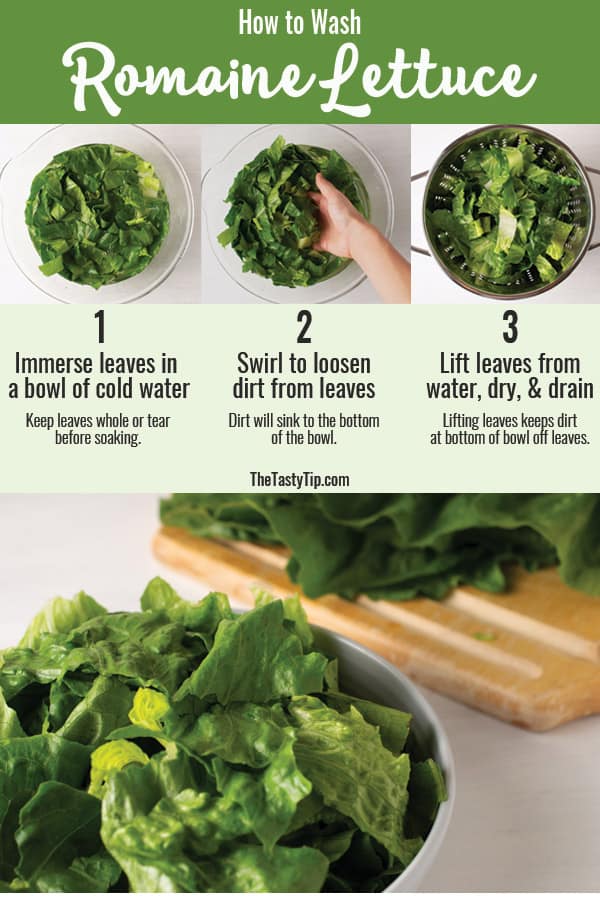
Soak Method
This method is best if you need the whole head of lettuce.
- Pull the leaves off the core or slice the core off with a knife.
- Separate the leaves.
- Throw out any bad or wilted leaves.
- Fill a bowl with cold water.
- Tear lettuce into strips or leave whole. I like to tear the lettuce so it is easier to swirl in the water.
- Immerse the leaves in the water.
- Gently swish the leaves in the water. If necessary, rub dirt off with your thumb.
- Pull out the leaves, discard the water, and repeat if needed.
- Spin to dry.
Leaf by Leaf
This method is best if you need only a few leaves, such as for a small salad or for a lettuce wrap.
- Pull apart each leaf from the lettuce core.
- Wash each leaf (front and back) under running water.
- Spin to dry.
Note: This method is fine for hearty lettuces like romaine. However, delicate lettuces can bruise under running water.
Spin to Dry
Use a salad spinner to spin the water off the lettuce. Empty the collected water and repeat, if necessary.
Salad dressing or a vinaigrette stick to the lettuce better when the lettuce is dry. If you are concerned that your lettuce is not dry enough after spinning it in a salad spinner, pat the leaves dry with a clean lint-free towel.
Simply place the leaves in a clean, lint-free towel and gently roll to blot and dry.
How to Cut Romaine Lettuce
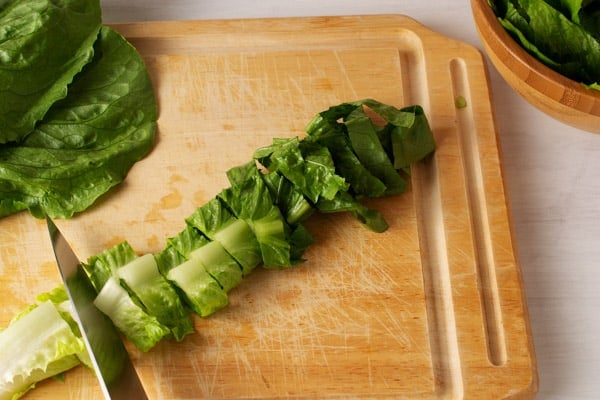
Three ways to cut lettuce:
- Tear lettuce leaves into bite-sized pieces
- Chop lettuce into bite-sized pieces with a knife
- Fold or roll lettuce into a cylinder shape and cut it into ribbons
How to Re-hydrate Wilting Lettuce
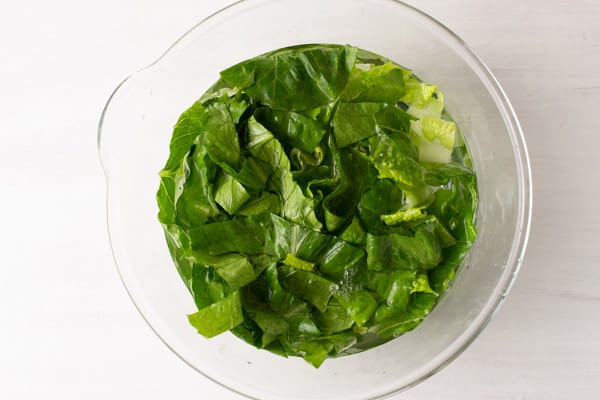
Submerge the lettuce in a bowl of ice water for about 30 minutes to refresh and crisp it again. Spin to dry before eating.
How to Eat Romaine Lettuce
The most common way to eat most lettuces is raw in a salad. However, there are other raw and cooked ways to eat it.
- Use the leaves as a “tortilla” and make a lettuce wrap. Romaine lettuce is ideal for a lettuce wrap because of the shape and strength of the leaves.
- Add to a smoothie or juice blend.
- Saute, broil, or braise.
- Top a spicy soup.
- Garnish a sandwich.
Romaine Lettuce Calories
Romaine lettuce has low calories. You will get only 8 calories in 1 cup of lettuce.
Romaine Lettuce Carbs
Romaine is low in carbs. You will only get 1.5g of carbohydrates in 1 cup of romaine lettuce.
Romaine Lettuce Nutrition Information

1 pound of romaine lettuce ≅ 6 cups
For each 1 cup of romaine lettuce you get:
- 8 calories
- 0.1g fat
- 0mg cholesterol
- 3.8mg sodium
- 1.5g carbohydrate
- 0.6g sugars
- 1g dietary fiber
- 0.6g protein
Healthy benefits of Romaine Lettuce
Top vitamins
- Vitamin K: helps blood clot, helps protect against osteoporosis
- Vitamin A: strengthens vision (especially night vision), antioxidant to neutralize free radicals, strengthens the immune system, keeps skin soft, helps synthesize proteins
- Folate: helps synthesize DNA and red blood cells
Additional Vitamins and Minerals
Listed below are some of the benefits from vitamins and minerals found in romaine lettuce. The majority of this information came from the book Vitamins and Minerals Demystified by Steve Blake.
- Vitamins B1, B2, and B6: helps with energy and metabolism, helps build amino acids and fatty acids
- Fiber: helps lower glucose levels, reduces cholesterol, helps treat diabetes, high blood pressure, and obesity, helps maintain regularity
- Manganese: antioxidant that helps synthesize glucose and detoxify ammonia, helps wound healing
- Biotin: helps with energy metabolism
- Copper: antioxidant that produces energy, synthesizes collagen, transports iron
- Molybdenum: helps with metabolism of sulfur-containing amino acids
- Iron: transports oxygen, metabolizes energy
- Potassium: maintains cell membrane potential, helps energy production, buffers acid
- Vitamin C: antioxidant that helps form collagen
- Omega-3 fats: helps brain function, neurodevelopment, cognition, mental health, and vision
- Chromium: helps insulin control blood sugar
- Phosphorus: strengthens bones and DNA cell membranes, maintains acid-base balance, helps in energy transfer
- Magnesium: strengthens bones, promotes muscle relaxation, stabilizes ATP
- Calcium: strengthens bones and teeth, helps muscles contract, helps blood vessels relax and constrict, helps nerve impulse transmission, helps secrete hormones like insulin, helps reduce high blood pressure, needed by proteins and enzymes
- Pantothenic acid: helps with energy metabolism
- Lutein and xeazanthin: carotenoids that help to keep eyes healthy
Romaine Lettuce Recipes
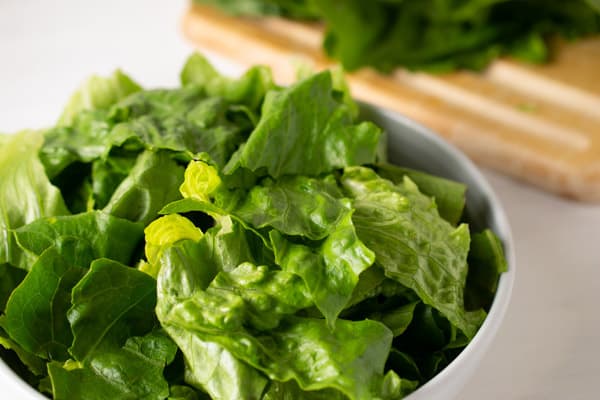
Romaine lettuce salads are very popular in our house. I recommend using romaine in Cobb Salad and Caesar Salad.
Did you like this post? Then let's be social. FOLLOW ME on PINTEREST and INSTAGRAM to keep up with the latest tutorials, favorite recipes and interesting happenings.

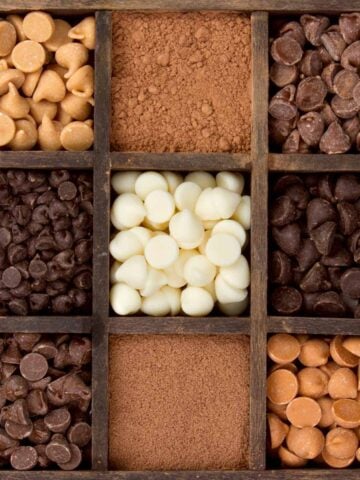
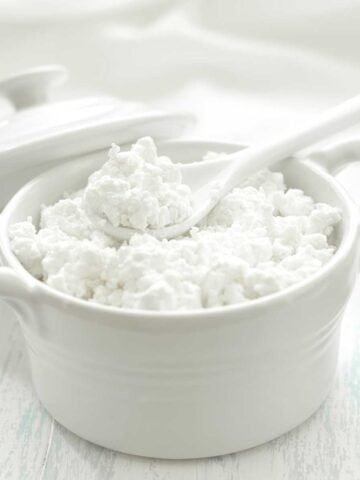

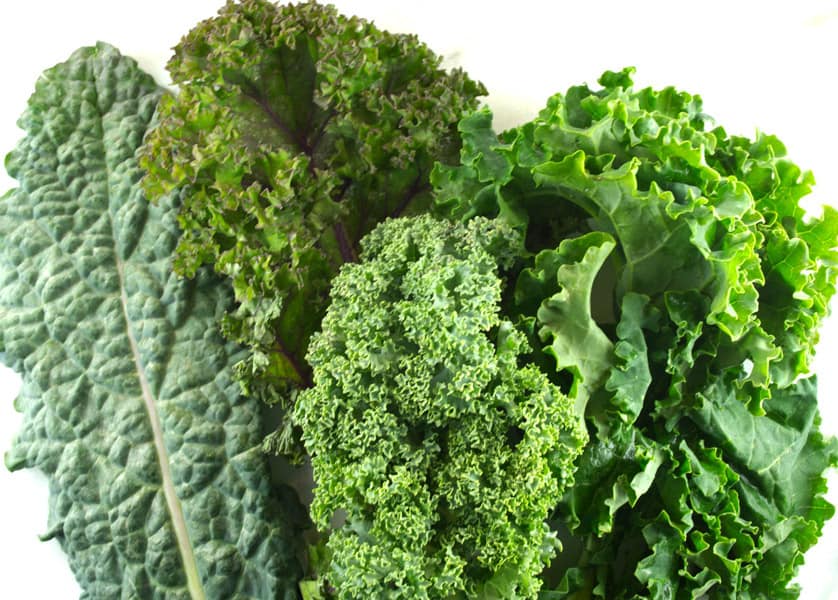
Comments
No Comments